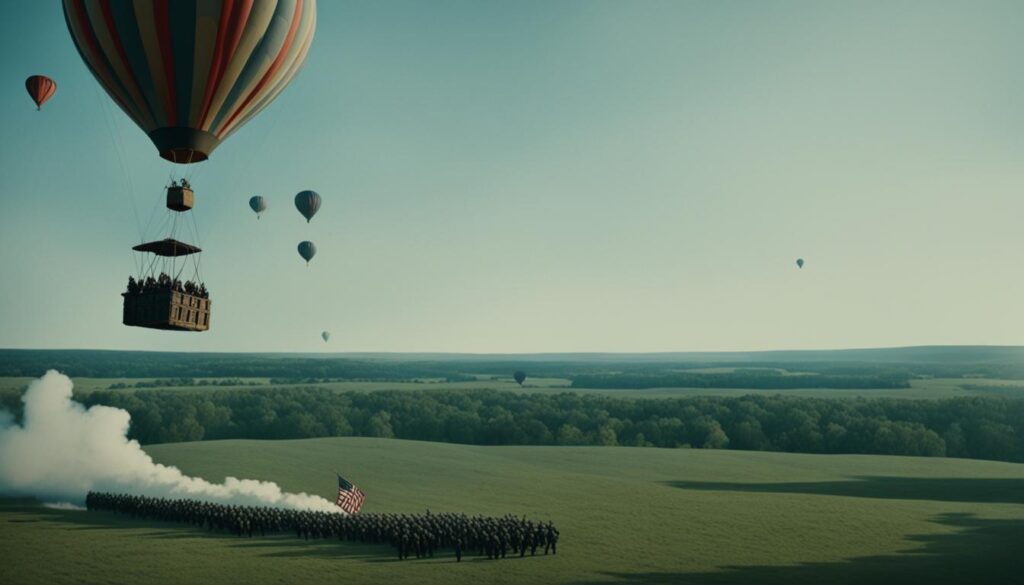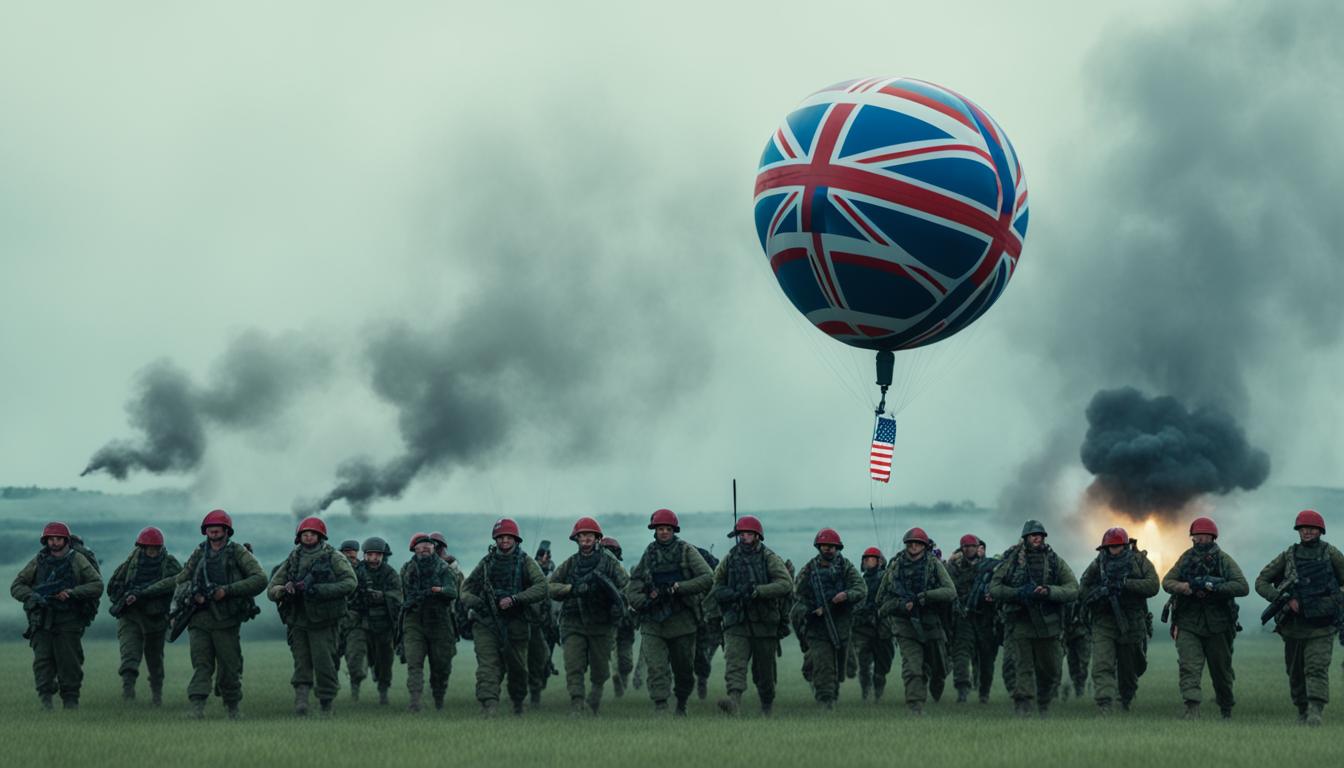In the early days of the Civil War, President Abraham Lincoln was seeking innovative ways to gain an advantage over Confederate forces. One such idea was the use of hot-air balloons for aerial reconnaissance missions. In 1861, Lincoln authorized the creation of the Union Army Balloon Corps, marking a significant milestone in military aviation history.
Before the war, ballooning was primarily associated with carnival performances and public spectacles. However, aeronaut Thaddeus Lowe saw the potential for balloons to be used in military operations. On July 11, 1861, Lowe demonstrated his ballooning skills for President Lincoln, showcasing how aerial surveillance could provide valuable intelligence on enemy troop movements and positions.
Impressed by Lowe’s demonstration, Lincoln gave the green light for the establishment of the Balloon Corps within the Union Army. This decision would pave the way for the first organized use of aerial reconnaissance in warfare, forever changing the landscape of military strategy and tactics during the Civil War.
Key Takeaways
- President Abraham Lincoln authorized the creation of the Union Army Balloon Corps in 1861.
- Aeronaut Thaddeus Lowe demonstrated the potential of balloons for aerial reconnaissance to President Lincoln.
- The Balloon Corps marked the first organized use of aerial surveillance in warfare.
- Ballooning transitioned from a carnival attraction to a valuable military asset during the Civil War.
- Lincoln’s decision to establish the Balloon Corps revolutionized military strategy and tactics.
The Birth of the Union Army Balloon Corps
The idea of using balloons as an air-war mechanism was pioneered by the French Aerostatic Corps at the Battle of Fleurus in 1794. Intrigued by the potential of balloon aviation for reconnaissance, President Abraham Lincoln sought to establish a similar unit within the Union Army. The notion gained traction at the War Department and Treasury, leading to the realization that a “Chief Aeronaut” would need to be appointed to head this innovative civilian operation.
Several renowned American aeronauts, including Thaddeus Lowe, John Wise, John LaMountain, and Ezra and James Allen, converged on Washington, each vying for the prestigious position. On June 11, 1861, Lowe seized the opportunity to demonstrate the capabilities of his balloon, the Enterprise, to President Lincoln himself. Ascending to an altitude of 500 feet from the armory lawn directly across from the White House, Lowe telegraphed a message to the President, detailing his panoramic view of the Washington, D.C., countryside.
Ultimately, Lowe’s impressive display secured him the role of chief aeronaut, triumphing over his fellow candidates. Under his leadership, the Union Army Balloon Corps was born, marking a significant milestone in the history of military aviation. This groundbreaking civilian operation would go on to play a crucial role in aerial reconnaissance during the Civil War, forever changing the landscape of battlefield intelligence gathering.
Aerial Reconnaissance During the Civil War
The Union Army Balloon Corps played a crucial role in aerial reconnaissance during the American Civil War. Under the leadership of Thaddeus S. C. Lowe, a group of skilled aeronauts utilized seven specially constructed, gas-filled balloons to gather intelligence on Confederate positions and movements. This innovative approach to warfare provided the Union Army with a strategic advantage in several major battles.
Lowe and his team of aeronauts participated in key engagements such as the First Battle of Bull Run, the Siege of Yorktown, the Battle of Fair Oaks, and the Siege of Vicksburg. During these battles, the Balloon Corps conducted aerial observations, created detailed maps, and relayed crucial information to Union commanders on the ground.

One of Lowe’s first assignments was with the Topographical Engineers, where he used his balloon for aerial observations and map making. He collaborated with Major General Irvin McDowell, who accompanied Lowe on preliminary observations over the battlefield at the First Battle of Bull Run. This marked the beginning of a new era in military tactics, as aerial reconnaissance proved its value in providing a bird’s-eye view of the battlefield.
Throughout the war, the Balloon Corps served along the Potomac River and the Virginia Peninsula, participating in numerous battles and campaigns. Their efforts contributed significantly to the Union Army’s understanding of Confederate positions and troop movements, enabling commanders to make more informed decisions on the battlefield.
Lincoln’s Civil War Balloon Corps in Action
During his demonstration, Thaddeus Lowe ascended 500 feet into the air and relayed a telegraph message about what he saw to Abraham Lincoln’s staff. Impressed by the successful showcase, Lincoln offered Lowe the role of chief aeronaut in the Balloon Corps, which formally began operations in October 1861. The primary purpose of the Balloon Corps was to gather intelligence about the Confederate Army’s location and relay it to Union troops on the ground, enabling them to fire on the enemy from a great distance without direct visual contact.
The Balloon Corps fleet quickly grew to include seven balloons, some of which were tethered to barges in the Potomac River. These barges effectively served as early precursors to the modern aircraft carrier, providing a mobile platform for the balloons to operate from. The aerial surveillance proved strategically beneficial, giving the Union Army a significant advantage in gathering intelligence and planning their military maneuvers.
Despite the clear benefits of the Balloon Corps, many Union officers, including General George B. McClellan, expressed concerns about the safety of the balloons. They feared that the balloons might be vulnerable to enemy fire or that the aeronauts could be captured, compromising the Union’s intelligence-gathering efforts. Nonetheless, Lincoln remained a strong supporter of the Balloon Corps, recognizing its potential to provide a crucial edge in the war effort.
The Demise of the Balloon Corps
Despite the initial successes and potential of aerial reconnaissance, the Union Army Balloon Corps faced numerous challenges that ultimately led to its disbandment. Chief among these were growing safety concerns, as the hydrogen-filled balloons proved vulnerable to enemy fire and unpredictable weather conditions. The lack of standardized military procedures and protocols for balloon operations also hindered the Corps’ effectiveness and integration with other army units.
Interpersonal conflicts and political rivalries further undermined the Balloon Corps. John LaMountain, a rival aeronaut, waged a prolonged campaign to discredit Thaddeus Lowe and usurp his position as Chief Aeronaut. LaMountain’s actions created ill-will among the Corps’ members and damaged morale. In February 1862, after Lowe lodged a formal complaint to General George B. McClellan, LaMountain was discharged from military service. However, the damage to the Corps’ reputation and cohesion had already been done.
Frustrated by the military’s lack of support, inadequate funding, and ongoing internal strife, Lowe ultimately resigned his post on May 7, 1863. The military’s failure to fully commission the Balloon Corps or its members, despite their valuable contributions, likely influenced Lowe’s decision. Shortly after his resignation, the Union Army Balloon Corps was officially disbanded, bringing an end to this pioneering chapter in military aviation history. The rapid communication hotlines that developed decades later during the Cold War built upon the hard lessons learned about the importance of real-time intelligence that the Balloon Corps first demonstrated.

Leave a Reply